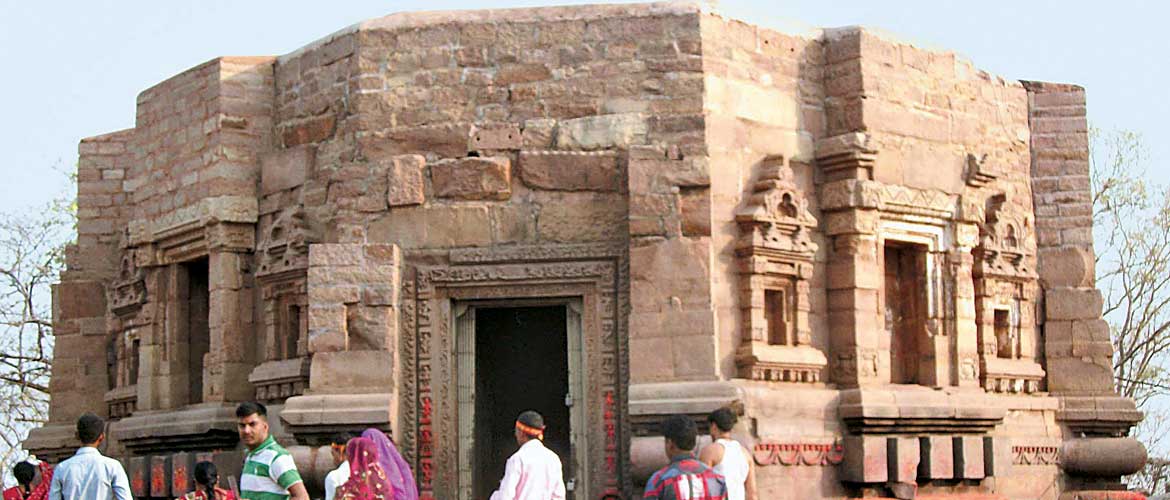With lush, verdant hills, expansive lakes, some of the biggest waterfalls in Bihar, the oldest
THINGS TO SEE AND DO
Mundeshwari Temple
The Mundeshwari temple is believed to be the oldest functioning temple of India. Archaeological evidence suggests that the shrine dates back to at least 635 CE. This ancient temple has an unusual octagonal shape.
Inside the shrine, there is a linga with four human faces, other images and two large stone vessels. From the debris of the mound, many carved pieces and sculptures have been unearthed. They include Shiva-Parvati, Ganesha, Surya, Kartikeya and Mahishasuramardini Durga among others, with a striking absence of Vaishanava figures.The temple has seen three periods of religious history: first, when it was a Vaishnava shrine of Lord Narayan; second, when it was converted into a Shaiva temple of Viniteshwara (another name for Lord Shiva); and third, when it was converted into the temple dedicated to Goddess Mundeshwari, perhaps under the Chero kings who were Saktas. The earliest sanctuary was of the 4th or 5th century. The existing ruins, representing mostly the second period of the history, belong to the 7th century CE.
Located atop a hill, the temple is accessible by a flight of steps.

Tomb of Bakhtiyar Khan
Chainpur is credited with a great mausoleum of Bakhtiyar Khan, who is said to have married the daughter of Sher Shah. The tomb at Maliksarai consists of a large court 288 ft by 230 ft, with a walled enclosure, the main mausoleum in the middle stands on a low plinth. The enclosure has two small doorways or khidkis, on its north and south and a square domed chamber at each of its four corners. The main gateway is on the east of the enclosure, consisting of a grand arched entrance with double storeyed chambers on both sides surmounted by two graceful cupolas on the two sides at the top. The main building of the tomb inside the court is octagonal in plan, 139 ft in diameter externally, including the 8 ft 4 inches wide arcaded verandah surrounding it on all sides. The verandahs are roofed over by 24 small domes, three on each side of the octagon. The main dome is further adorned with graceful pillared cupolas on the corners of the octagon, a similar cupola taking the place of the finial to crown the top of the building. Internally, the tomb chamber is 56 ft in diameter and contains 30 graves in addition to that of Bakhtiyar Khan. In the open courtyard outside, there are a number of graves scattered about.
Chainpur Fort
This small village boasts a fort that is believed to have been the seat of the Sakawar Rajput family.
It is not confirmed whether the fort dates to the Suri or Akbar period, but it is attributed to one of the chiefs of the Chainpur family – Raja Salivahana.
Inside the fort is the small Hindu shrine of Harsu Brahm. It is said that Raja Salivahana’s priest, Harshu Pandey, ended his life in protest against the demolition of his house. Eventually, the temple was built in his honour.

Kaimur WLS
This wildlife reserve is quite rich in terms of its flora and fauna. Situated in the Kaimur district, the Kaimur Wildlife Sanctuary is spread over an area of more than 1,300 km, and is one of Bihar’s largest reserves. The ideal time to visit the Kaimur sanctuary is anytime between October and March.
You can spot black bucks, nilgai, chinkara, tiger, hyena, wild boar and sloth bear: the species commonly found in these forests. If you are lucky, you might even spot a big cat the sanctuary is also home to tigers and leopards.
Birding enthusiasts should bring along their binoculars: you can spot several species of birds here, including nightjars, drongos, owls, kites, eagles, peafowls and bulbuls.
A large number of migratory birds also can be spotted here in winter. The landscape is thickly wooded, and has a variety of trees such as teak, saal, mahua, salai, siddha, koraiya and more.
Accommodation is in a forest guesthouse that has separate charges for Indians (₹100) and foreigners (₹300).
Entry Indians ₹30; Foreigners ₹350; separate fee for entry by car, jeep, motorcycle or a bus.
WHERE TO STAY AND EAT
Stay at BSTDC’s Kaimur Vihar (Tel: 06187-222822; Tariff: ₹525-1,800) on NH2 in Mohania. The hotel has decent amenities and a restaurant. The restaurants and hotels lining GT Road serve Indian and Chinese fare. Try Upvan or Radha Krishan Hotel.
When to go October to March Location In southwest Bihar, with the Kaimur range and Rohtas plateau covering the southern part of the district Air Nearest airport: Gaya Rail Nearest railhead: Bhabua Road Station
|
THE INFORMATION |
|
Tourist Offices Directorate of Tourism Frazer Road, Patna Tel: 0612-2332042, Tollfree: 1800 3456112 W bihartourism.gov.in |
|
BSTDC Beer Chand Patel Path, Patna Tel: 0612-2225411, 2506219 W bstdc.bih.nic.in Jehanabad |
|
Tourist Information Centre Bihar Tourism, Gaya Tel: 0631-2200672, Cell: 09471006727 STD code 06114 Rohtas |
|
BSTDC Shershah Vihar Faizalganj, Sasaram Tel: 06184-221267 STD code 06184 Kaimur |
|
BSTDC Kaimur Vihar, NH2, Mohania Tel: 06187-222822 STD code 06187 Motihari |
|
Tourist Information Centre Railway Station, Raxaul STD code 06252 Darbhanga |
|
Tourist Information Centre Railway Station, Muzaffarpur Cell: 07631347248 STD code 06272 |
|
THE INFORMATION |
|
Bhagalpur Tourist Information Centre Cell: 09801566828 STD code 0641 Munger |
|
Tourist Information Centre Fort Area, Munger Cell: 09801566828 STD code 06344 |
Bihar
Chainpur
Chainpur Fort


